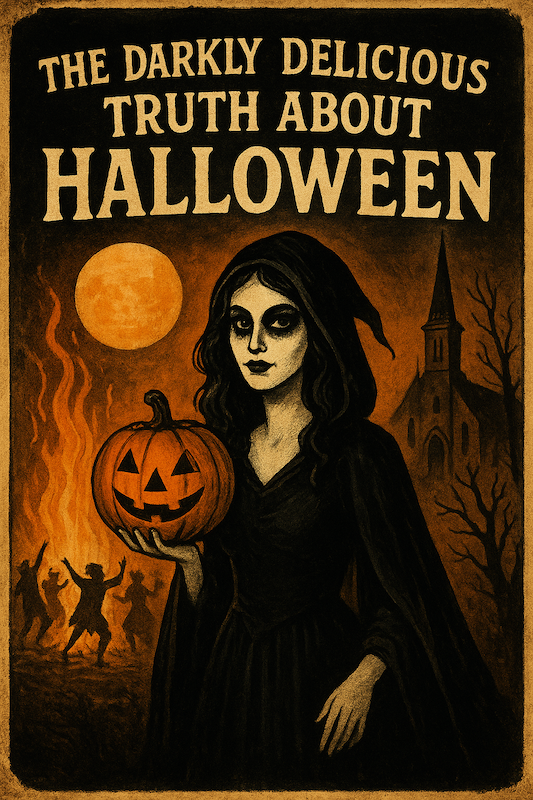The darkly delicious truth about Halloween
- Activities
- Attractions
- Published on Thursday, 30 October 2025 11:10
- Last Updated on 31 October 2025
- Lady Rantingham
- 0 Comments
Oh, my darling ghouls and sceptics, let’s drop the plastic pumpkins and talk truth. Halloween – that glitter-covered parade of cobwebbed nonsense – didn’t begin with a candy company or a Hollywood slasher flick. No, my loves, it was born from bonfires, bones, and the exquisite terror of the unknown.
You see, before Starbucks sold “Pumpkin Spice Anything,” there were Celts – fierce, muddy, magnificent people – dancing around flames on the edge of the known world. The night was called Samhain, and it marked the end of the harvest, when the veil between the living and the dead was rumoured to flutter thin enough for the dearly departed (and the not-so-dearly) to pop back in for a visit. And naturally, to avoid being possessed or pestered by wandering spirits, the Celts dressed in animal skins and smeared soot on their faces – not to win a costume contest, but to survive the night.
Fast forward a few centuries, and along comes the Church – ever the master of rebranding – declaring, “Let’s make this holy!” and calling it All Hallows’ Eve. A rather brilliant PR move, if you think about it. They basically slapped a saintly halo on an ancient pagan rave and told everyone it was divine. Thus Halloween, in its church-sanctioned disguise, was born.
Now, London had more than its fair share of All Hallows churches, with at least half a dozen across the city by the Middle Ages. The most famous, All Hallows-by-the-Tower, founded around AD 675, still stands tall beside the Tower of London. These churches were once the heart of All Hallows’ Eve observances – nights filled with tolling bells, candlelight processions, and prayers for the souls of the departed. It was solemn, spiritual, and tinged with awe rather than fright.
But London has always had a habit of turning piety into pageantry. Over the centuries, the city’s All Hallows vigils slowly morphed from religious reflection into rowdier affairs -a mix of mischief, mumming, and masked revelry. By the time the Victorians arrived with their appetite for gothic fantasy and ghost stories, Halloween had already become what it is today: a festival where the sacred and the scandalous meet under flickering candlelight.
Because here’s the delicious irony, isn’t it? Halloween began as a spiritual confrontation with mortality – and now it’s a night when people dress as cats, eat chocolate, and pretend death doesn’t exist. The Celts would have howled with laughter. They faced the dark with fire and courage; we face it with novelty teeth from Tesco.
But perhaps that’s the most human thing of all – to take the unbearable truth of our own fragility and turn it into a festival. To laugh in the face of ghosts, to dress them up, and make them part of the party. Deep down, Halloween is about rebellion against fear itself. It says: You don’t scare me, Death – have a toffee apple.
And before anyone clutches their pearls about “paganism” – let’s remember the Church didn’t erase Samhain, it simply rebranded it. (Frankly, mediaeval Christians invented the original corporate merger.) “All Hallows’ Eve” gave people permission to do what they were already doing – communing with their dead, burning candles, and wearing disguises – only now with heavenly PR. Clever devils, those priests.
Yet here’s the truly scandalous thought: perhaps Halloween has come full circle. In our sanitised, endlessly online world, Halloween remains one of the few days we can still play with the sacred and profane, light and dark, beauty and grotesque – without apology. It’s a catharsis. An annual permission slip for our shadow selves.
Think about it: women become witches, men become monsters, and the quiet ones reveal their inner demons – and everyone smiles and says, “Nice costume.” But sometimes, it’s not a costume at all. It’s the truth finally allowed out for air.
That, my dears, is the genius of Halloween.
It’s not just about sweets and spooks. It’s about freedom.
Freedom from good manners. From workplace decorum. From that tedious daylight version of ourselves we parade the rest of the year.
For one glorious night, we reclaim our wildness. We wear our fear as fashion. We mock death with glitter.
And if you listen closely – past the fake cobwebs, past the canned laughter of horror films, past the hum of the LED pumpkin lights – you can almost hear it. The ancient crackle of the bonfire. The heartbeat of the earth turning toward winter.
The whisper of ancestors saying:
Remember us.
Dance while you can.
So, go ahead.
Paint your face.
Raise your glass.
And if anyone tells you Halloween is silly, childish, or commercial – smile sweetly and say,
“Darling, it’s older than your religion.”
Yours Lady Rantingham, ever your elegantly insubordinate guide to the underworld and beyond.
Lady Rantingham: The unconventional Voice with a bit of sass
Meet Lady Rantingham, a witty and rebellious spirit who brings a fresh twist to the “Rant” theme. While her name might evoke a touch of aristocracy, she’s anything but conventional. With a playful, humorous tone and a slight air of authority, Lady Rantingham is here to run riot on just about anything – especially the things that bother her.
Whether it’s the little annoyances of everyday life or the larger absurdities of the world around her, Lady Rantingham isn’t afraid to call out what grinds her gears. Her rants are filled with sharp wit, unfiltered thoughts, and an unapologetic perspective that blends rebellion with a dash of humour.
Her commentary goes beyond just mockery; she touches on everything from societal quirks to the frustrating intricacies of modern life, all while maintaining a sense of lighthearted authority. Lady Rantingham isn’t just ranting about the monarchy — she’s ranting about anything that makes her roll her eyes.
